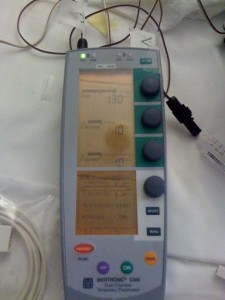Cardiac surgery patients are different from many other patients for a number of reasons when it comes to resuscitation post arrest.
- arterial line, Swan-ganz catheter (generally), and cardiac monitor; thus allowing for very early defibrillation without the use of external cardiac massage (ECM).
- ECM should be avoided if at all possible due to risk of trauma to the surgical site.
- The cardiac surgery patient usually has pacer wires.
- If defibrillation is unsuccessful the patient can undergo a rapid sternotomy.
In the event of a cardiac arrest in the cardiac surgical patient the arterial line, PA (pulmonary artery), CVP (central venous pressure), and O2 Saturation wave forms will be flat. One should check for a femoral pulse for 10 seconds, and if absent, initiate the cardiac arrest protocol.
V-FIB ARREST
Immediately perform three successive attempts at defibrillation, prior to any attempts at ECM. This increases the likelihood of restoring the patients cardiac output. Biphasic rather than monophasic defibrillation is recommended at the optimal strength for the defibrillator in use. After 3 failed attempts at defibrillation for v-fib or pulseless v-tach initiate ECM, give 300 mg of Amiodarone IVP, and then an emergency resternotomy should be performed.
NON-SHOCKABLE ARREST
Asystole and severe Bradycardia should be treated with atropine and pacing. Connect the epicardial pacing wires to the pacemaker (if not already connected) and set for DDD (dual chamber sensing and pacing) pacing at a rate of 90 with the atrial and ventricular outputs set at their maximum output. If the pacemaker is already connected and the rhythm is pulseless electrical activity turn the pacemaker off for a few seconds to rule out underlying v-fib. Non-shockable rhythms that do not respond to atropine or pacing should immediately have a resternotomy performed. 
DRUGS AND INFUSIONS
- Once a cardiac arrest has been identified all drips should be stopped and appropriate medications for the arrest situation identified.
- Epinephrine
Should not be routinely used for cardiac surgery patients.
Any use should be delayed until reversible causes of arrest identified.
If use of epinephrine is found to be needed then smaller doses should be used.
Should only be administered by a senior clinician and should not form part of the arrest protocol.
- Internal cardiac massage is more effective than ECM.
- When the arrest is suspected to be prolonged emergency resternotomy is indicated.
- A sternotomy set should be available in units that care for cardiac surgery patients and these sets should be monitored daily for expiration dates and correct supplies being present (just like a crash cart).
Included on the outside of the set should be a wire cutter, draping, disposable scalpel, a heavy needle holder, and a sternal retractor.
- Successful resternotomy requires a team that has practiced the procedure regularly and each team player knowing their specific role.
- Generally emergency resternotomy should be considered up to the 10th post-operative day. After this the decision to perform an emergency resternotomy would be up to physician in charge of the patient.
The next blog post will address the resternotomy in more depth.
Nurses reviewing cases involving the arrest of a cardiac surgery patient should focus on the protocol used during the arrest. Was the use of ECM minimized, was early defibrillation taken advantage of, was there routine use of epinephrine (this should not occur), was pacing attempted using the proper settings, and was an emergency resternotomy done in a timely manner (5-10 minutes post arrest).
If you have a case involving an arrest in a Cardiac Surgery patient, Alvin & Associates, Legal Nurse Consultants would be happy to assist you with a review of your case.
Works Cited
Adam, Z., Adam, S., Everngam, R. L., Oberteuffer, R. K., Levine, A., Strang, T., et al. (2009, February 23). Resuscitation after cardiac surgery: results of an international survey. Retrieved August 21, 2013, from European Journal of Cardiac-Thoracic Surgery: http://www.papworth-anaesthesia.org/new/docs/EJCTS-2009-36-29.pdf
Dunning, J., Fabbri, A., Kolh, P. H., Levine, A., Lockowandt, U., Mackay, J., et al. (2009, January 22). Cardiac Arrest after Cardiac Surgery–Is it Different than ACLS? Retrieved August 26, 2013, from SHA 22: http://www.sha-conferences.com/files/presentation2011/095001.pdf
Leave a Comment